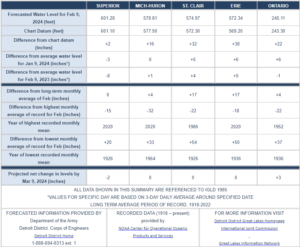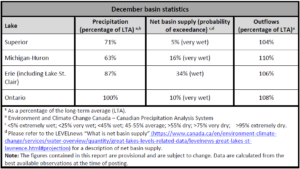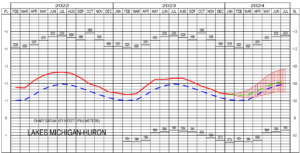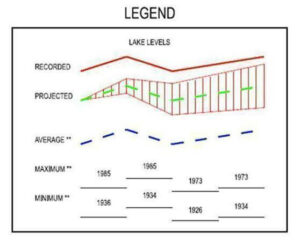2024-Feb-12
February 11 Water Levels Report
January was unusually warm and the warm weather has continued into February, so far this month.
Lake Michigan-Huron is now up 1 inch from its level at this time last year. From a month ago the water levels on Lakes Superior & Michigan-Huron, are down 3 & 0 inches, respectively, and Lakes St Clair, Erie & Ontario are up by 5, 6 & 6 inches, respectively. Lakes Superior & Ontario are lower by 8 & 1 inches, respectively, and Lakes Michigan-Huron, St Clair & Erie are up 1, 4 & 5 inches, respectively, than they were at this time last year. Lakes Superior, Michigan-Huron, St Clair, Erie & Ontario are 0, 4, 17, 17 & 4 inches, respectively, above their long-term February average. All the lakes remain well below their February record highs.
In a month’s time Lakes Superior, Michigan-Huron, St. Clair & Erie are expected to fall by 2, 0, 0 & 0 inches, respectively, and Lake Ontario is expected to rise by 3 inches.

![]()

Outflows from Lake Superior into the St. Mary’s River are expected to be near average, whereas Lake Michigan-Huron’s outflow into the St. Clair River, Lake St. Clair’s outflow through the Detroit River, Lake Erie’s outflow through the Niagara River, and Lake Ontario’s outflow through the St. Lawrence River and are all projected to be above average for this month.
This report below shows the most recent month of precipitation and outflows published by Level News:

With regard to the forecast graph below, and the more recently updated first graph in this report, the USACE is predicting that the most likely outcome is that the Lake Michigan-Huron level will start to drop in January, level off in February and then rise again in March through June.
Monthly mean water levels for the previous year and the current year to date are shown as a solid line on the hydrographs. A projection for the next six months is given as a dashed line. This projection is based on the present condition of the lake basin and anticipated future weather. The shaded area shows a range of possible levels over the next six months dependent upon weather variations. Current and projected levels (solid and dashed lines) can be compared with the 1918-2021 average levels (dotted line) and extreme levels (shown as bars with their year of occurrence). The legend below further identifies the information on the hydrographs.


There is no clear recent satellite image since the one shown last week, but, from the partial images available, there appears to be very little ice cover on Georgian Bay and the North Channel.
